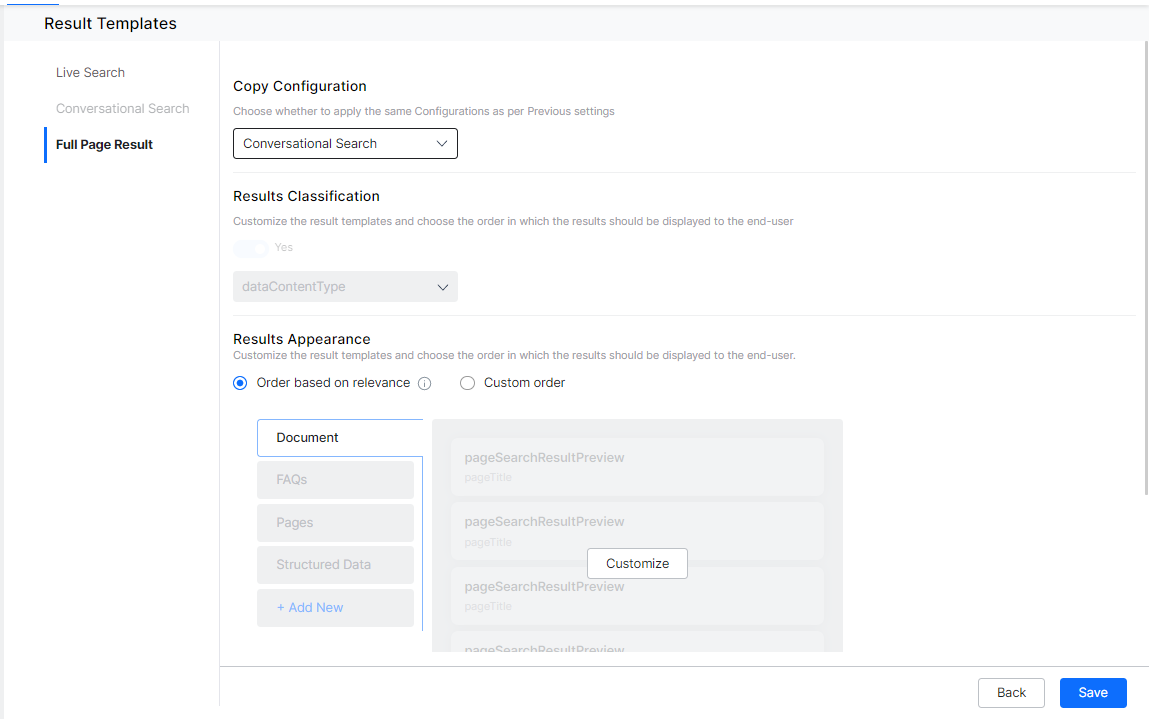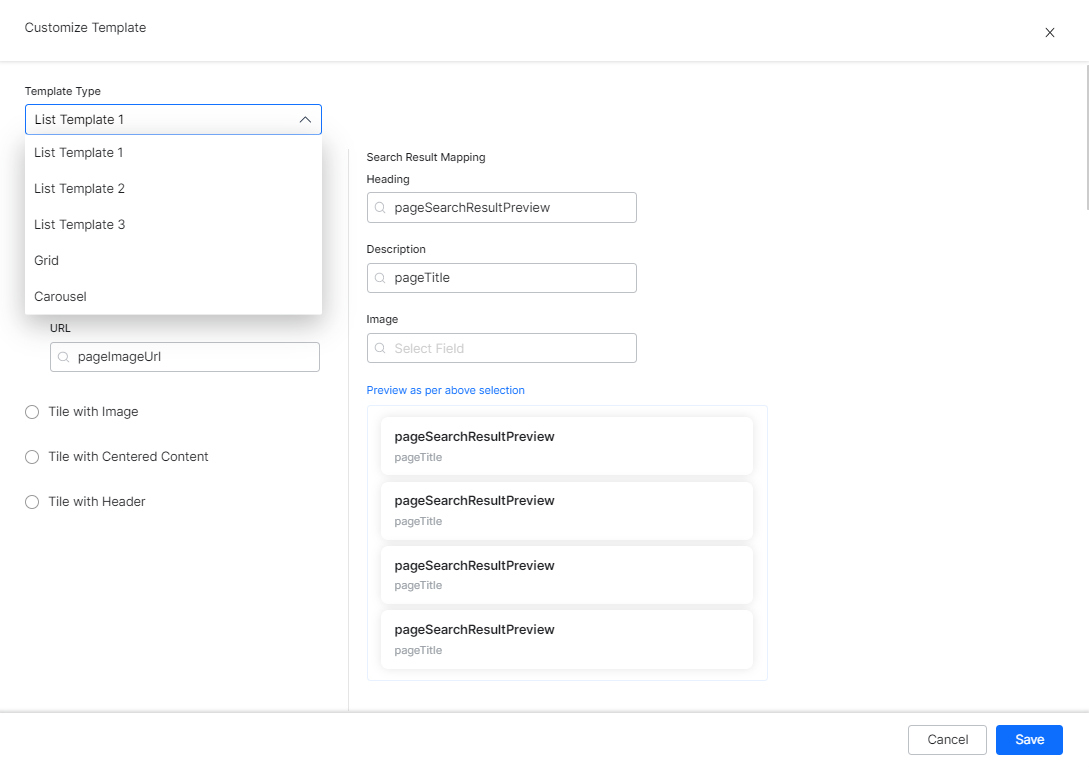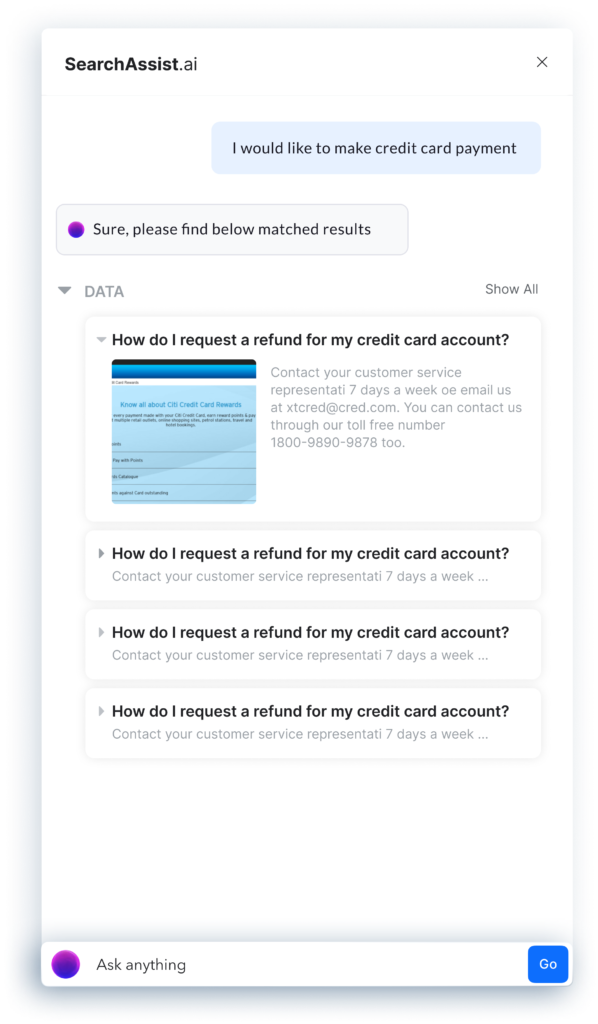SearchAssist allows you to customize the Result Templates and the way in which the results should be displayed to the search user so that they always see the results in a more meaningful way.
You can configure the Result template for the following result types (see here for details on search result types):
- Live Search displays the results as the user is typing the query.
- Conversational Search displays the results in the chatbot with a link to view the full page results. This option is available only for the bottom-up search experience.
- Full Page Results display the complete results, on the main page in case of top-down search experience or as a slide-out page when the user selects the option in case of bottom-up search experience.
Features
Following are the main customizations you can do for search results presentation:
- Result Template can be set to be displayed as a:
- List of cards (List Template 1),
- Plain list (List Template 2),
- Block of lists (List Template 3),
- Grid, or
- Carousel.
- For the selected template you can set the Search Result Layout to one of the following:
- Tiled layout with just the Text,
- Tiled layout with Image and text, you can specify the field for the image,
- Tiled layout with Centered Content, or
- Tiled layout with Header.
- For each layout, you can map fields to be displayed on the various areas applicable in the search result layout, like:
- Header,
- Description,
- URL, and
- Image.
- The results can be static information or leading to a task or detailed pages, for this you can configure the results to be clickable or not:
- If results are set to be clickable, the results will act as a link to the value in the field that is mapped to the URL. This is the default option for Grid and Carousal templates and is non-editable.
- Results can be set to be non-clickable for list templates. In such cases, the results will be presented in an expanded/collapsed state depending on the content in the response.
- Text alignment for grid and carousel templates can be specified as left or right.
- Results can be classified based on a field. By default, the classification field is set to SourceType i.e the results will be categorized and displayed into Pages, FAQs, Actions, Structured Data, and Files. Currently, the classification field is non-editable.
- Based on the category, the following layouts are set by default, which you can retain or modify:
- FAQ – Tile with Text,
- Pages – Tile with Image,
- Files – Tile with Header,
- Structured data – default template is not defined, you have to set a template,
- Bot Actions – Tile with Header, non-editable (see here for customizing bot actions display).
- The order in which the results are presented can be set to:
- Based on relevance of the top most search result in each category.
- Custom – You can drag and drop the categories in any preferred order.
Configuration
To configure the Search Results Template, follow the below steps:
- On the Templates page, by default, the Live Search tab is selected. Choose the search result you want to configure – Live Search, Conversational, or Full Page Results.
Note: You cannot customize the Conversational Search for a Top-Down search experience.
- You can configure from scratch or Copy Configuration of a previous setting from the drop-down list.
- Under the Results Classification section, you can choose some other field for result classification. Currently, it is set to dataContentType field and is non-editable.
- Under the Results Appearance section, select an option:
- Order based on relevance
- Custom order
- Next, you can customize the template. Hover over the sample template and click Customize.

- On the Customize Template dialog box, select a template type from the Template Type drop-down list. For example, Grid or Carousel.

- Under the Search Result Layout section, select an option like Tile with Text, Tile with Image, Tile with Centered Content, and Tile with Header.
- Turn on the Clickable radio button to search results clickable and map a field to the URL.
- Under the Search Result Mapping section, map the fields for Heading, Description, Image (where applicable).
- You can Preview the results templates.
- For Grid and Carousel templates, you can set the Text Alignment to Left Aligned or Center Aligned.

- Click Save.
- For Full Page Result, you can configure the Facet. Under the Facets section,
- Enable or disable the facets, by turning on or off the toggle
- Once enabled you can set the position of the facet – left, right, or top.
- Click Save.




